Armor and Armament
Armor-
Hull protection for the battleship consisted of carbon-hardened
(Harveyized) steel armor belts of 18 inch thick steel that rose
three feet above the waterline and extended four and half feet
below the waterline. Behind this was six inches of wood and behind
this was two 3/4 inch steel plates and finally a ten foot belt
of bunkered coal.
To supplement the armor of ship built in the 1890's, including the USS
Oregon, a material called "woodite" or cellulose were packed
into the cofferdams of the ships. The cellulose consisted of extracts from
coconut husks mixed with small proportions of coconut fiber. These were then
pressed into briquettes and then placed into the cofferdams and then further
compressed under a pressure of about 200 psi. Later, American corn pith
was used, as it was cheaper and lighter that the coconut based cellulose.
The theory behind the use of cellulose was that if the ship's hull was
punctured, the incoming sea-water would cause the cellulose to expand and then
plug the hole. Unfortunately, condensation or minor leaks in the
cofferdams would cause the cellulose to deteriorate, leaving behind a mess that
proved hazardous and a great inconvenience to clean up. The use of
cellulose was soon discontinued.
The armored redoubts of the main battery consisted of steel
17 inches thick and rose above the main deck three and half feet.
The redoubts provided protection for the turning gear of the thirteen
inch rifles and the equipment and mechanisms required to reload
the rifles. Of interest, the Bureau of Ordnance wanted ships turrets to have the
conical, sloping sides to better deflect shell hits, but this would have
required a completed redesign of the gun mounts and loading equipment
arrangements, so the Civil War era pillbox shape was retained. The
original blueprints for the Indiana class show sloping turret
faces
The military mast (foremast) which housed voice tubes, electrical
wiring, and steering connections, was protected by ten inches
of armor.
Armor Protection for USS Oregon
|
Location |
Armor thickness |
|
Side Belt |
18-8 inches |
|
Armored Deck |
3 1/4 inches |
|
13 inch turrets |
15 inches |
|
13 inch barbettes |
17 inches |
|
8 inch turrets |
6 inches |
|
8 inch barbettes |
8-6 inches |
|
8 inch turret tube |
3 inches |
|
6 inch guns |
5 inches |
|
6 pdr guns |
2 inches |
|
1 pdr guns |
2 inches |
|
Conning Tower |
10 inches |
|
Armored Tube |
7 inches |
Armament-
The armament of a ship is essential to how a ship functions
in a fleet. Below is a chart listing the armament of the USS
Oregon during her service life. A ship is constantly being
upgraded and thus weapons will change in an effort to keep the
ship modern and up to date with the current threats that are posed.
It becomes a "game" of measure and counter-measure.
Below is a chart that shows the weapon systems that were installed
during the service life of the Oregon.
Armament carried by the USS Oregon (2 yr increments)
|
|
1896 |
1898 |
1900 |
1902 |
1904 |
1906 |
1908 |
1910 |
1912 |
1914 |
1916 |
1918 |
1920 |
1922 |
1924 |
1926 |
|
13" |
4 |
4 |
4 |
4 |
4 |
4 |
4 |
4 |
4 |
4 |
4 |
4 |
4 |
4 |
4 |
4 |
|
8" |
8 |
8 |
8 |
8 |
8 |
8 |
8 |
8 |
8 |
8 |
8 |
8 |
8 |
8 |
8 |
8 |
|
6" |
4 |
4 |
4 |
4 |
4 |
4 |
4 |
0 |
0 |
0 |
0 |
0 |
0 |
0 |
0 |
0 |
|
3" |
- |
- |
- |
- |
- |
- |
12 |
12 |
12 |
12 |
12 |
12 |
12 |
12 |
12 |
0 |
|
6pdr |
20 |
20 |
20 |
20 |
20 |
20 |
8 |
8 |
8 |
8 |
8 |
8 |
8 |
8 |
8 |
8 |
|
1pdr |
6 |
6 |
6 |
6 |
6 |
6 |
2 |
2 |
2 |
2 |
2 |
2 |
2 |
2 |
2 |
2 |
|
MG |
2 |
2 |
2 |
2 |
2 |
2 |
2 |
2 |
2 |
2 |
2 |
2 |
2 |
2 |
2 |
0 |
|
Torp |
4 |
4 |
4 |
4 |
4 |
4 |
0 |
0 |
0 |
0 |
0 |
0 |
0 |
0 |
0 |
0 |
Legend -
- 13" = 13 inch rifles (Main Battery)
- 8" = 8 inch rifles (Secondary Battery)
- 3" = 3 inch Anti Destroyer rifles
- 6 pdr = 6 pound cannons
- 1 pdr = 1 pound cannons
- MG = Machine Guns
- Torp = Torpedoes
The USS Oregon also carried a variety of small arms for landing
parties and security including a 3" man portable cannon (see the Landing
Party section of the Weapons page), .38 cal pistols, .45 cal pistols, .303
rifles, and .50 rifles (Browning Automatic Rifle).
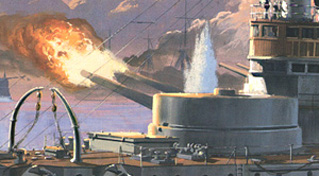 The main battery
of the USS Oregon consisted of four (4) thirteen inch breech
loading naval rifles in two revolving turrets (designated Mark
II), one mounted centerline forward and one centerline aft. The
turrets themselves were protected by armor 17 to 20 inches thick.
The main battery
of the USS Oregon consisted of four (4) thirteen inch breech
loading naval rifles in two revolving turrets (designated Mark
II), one mounted centerline forward and one centerline aft. The
turrets themselves were protected by armor 17 to 20 inches thick.
The turrets on the Oregon traversed by means of a hydraulic
power drive, unlike her sister ships, Indiana, and Massachusetts,
which had steam powered mechanisms.
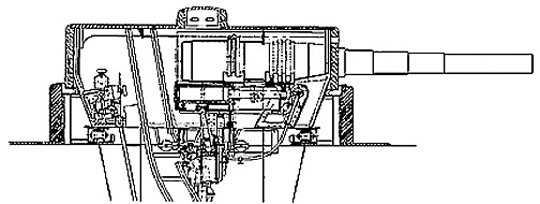 Line drawing of a Mark II 13 inch gun
turret
Line drawing of a Mark II 13 inch gun
turret
13" Main Battery
|
Model |
Mark II |
|
Diameter of Bore |
13 inches |
|
Caliber |
35 |
|
Weight of Armor Piercing shell |
1,130 pounds |
|
Muzzle Velocity |
2,000 feet per second |
|
Maximum Range |
16,000 yards |
Throw weight of main and secondary batteries = 5664
pounds
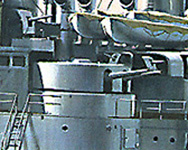 The eight
(8) eight inch rifles of the secondary battery were enclosed in
four revolving turrets located in wing mounts, port and starboard,
just behind and below the bridge and aft, port and starboard,
just behind the boat deck. They were protected by steel eight
and half inches thick. The barbettes of the eight inch turrets
were ten inches thick.
The eight
(8) eight inch rifles of the secondary battery were enclosed in
four revolving turrets located in wing mounts, port and starboard,
just behind and below the bridge and aft, port and starboard,
just behind the boat deck. They were protected by steel eight
and half inches thick. The barbettes of the eight inch turrets
were ten inches thick.
8" Secondary Battery
|
Model |
Mark III and IV |
|
Diameter of Bore |
8 inches |
|
Caliber |
35 |
|
Weight of Armor Piercing shell |
260 pounds |
|
Muzzle Velocity |
2,100 feet per second |
|
Maximum Range |
8,000+ yards |
The secondary battery also included four (4) six inch breech
loading rifles located in main deck casemates amidships.
An intermediate battery of twenty (20) six pound cannons were
situated on the superstructure, main deck amidships casemates,
and bridge decks. Hull casemates located at the extreme bow and
stern of the ship contain four (4) one pound cannons (two forward
and two aft), and located in the fighting tops (foremast) are
two more one pound cannons and two Gatling guns.
The Oregon, like all naval vessels, provided crew members
for the security of the ship and could form a landing party consisting
of marines and sailors. Thus the ship contained various small
arms such as pistols, rifles, grenades, and machine guns.
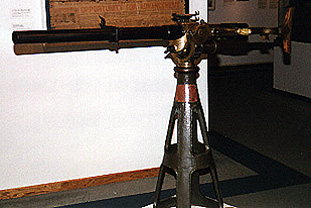
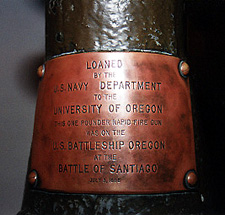
Above: Photographs of a one pound gun that
was on the USS Oregon at the time of the Spanish-American
War. This gun is located at the Maritime Museum in Astoria, Oregon,
The plate in the right picture states that the gun was loaned
by the Navy Department to the University of Oregon.
The USS Oregon and her sisters also carried torpedo
armament which consisted of six (6) eighteen Whitehead Torpedo
Tubes. The torpedo rooms were situated centerline forward and
aft.
BACK
TO SHIP STATISTICS
 The main battery
of the USS Oregon consisted of four (4) thirteen inch breech
loading naval rifles in two revolving turrets (designated Mark
II), one mounted centerline forward and one centerline aft. The
turrets themselves were protected by armor 17 to 20 inches thick.
The main battery
of the USS Oregon consisted of four (4) thirteen inch breech
loading naval rifles in two revolving turrets (designated Mark
II), one mounted centerline forward and one centerline aft. The
turrets themselves were protected by armor 17 to 20 inches thick. The eight
(8) eight inch rifles of the secondary battery were enclosed in
four revolving turrets located in wing mounts, port and starboard,
just behind and below the bridge and aft, port and starboard,
just behind the boat deck. They were protected by steel eight
and half inches thick. The barbettes of the eight inch turrets
were ten inches thick.
The eight
(8) eight inch rifles of the secondary battery were enclosed in
four revolving turrets located in wing mounts, port and starboard,
just behind and below the bridge and aft, port and starboard,
just behind the boat deck. They were protected by steel eight
and half inches thick. The barbettes of the eight inch turrets
were ten inches thick.
